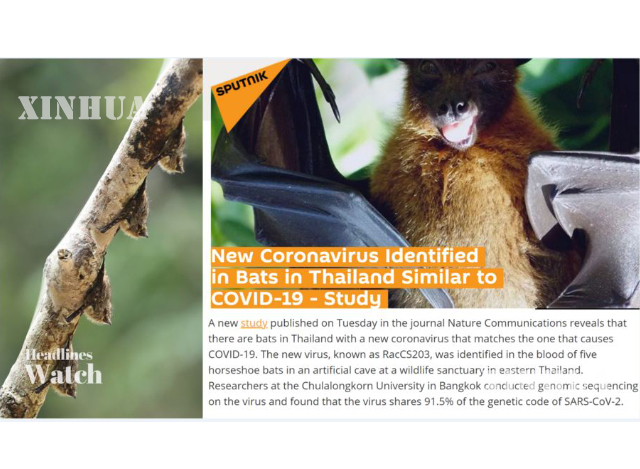WORLD
ထိုင်းနိုင်ငံတွင် COVID-19 ရောဂါနှင့်အသွင်သဏ္ဌာန်တူသော ကိုရိုနာဗိုင်းရပ်စ်ပိုး သယ်ဆောင်ထားသည့် လင်းနို့များ လေ့လာတွေ့ရှိ

ပေကျင်း၊ဖေဖော်ဝါရီ ၁၄ ရက်(ဆင်ဟွာ)
COVID-19 ရောဂါဖြစ်ပွားစေသော အကြောင်းအချင်းအရာများနှင့် ကိုက်ညီမှုတစ်ခုဖြစ်သည့် ကိုရိုနာဗိုင်းရပ်စ်ပိုး သယ်ဆောင်ထားသော လင်းနို့အုပ်စုငယ် တစ်ခုကို ထိုင်းနိုင်ငံအရှေ့ပိုင်းတွင် လေ့လာမှုအသစ်တစ်ရပ်အရ တွေ့ရှိခဲ့ကြောင်း သတင်းဖော်ပြချက်များအရ သိရသည်။
ထိုင်းနိုင်ငံတောရိုင်းတိရစ္ဆာန် ထိန်းသိမ်းစောင့်ရှောက်ရေးနေရာတစ်ခုရှိ လူလုပ်ဂူတစ်ခုအတွင်းမှ
(horseshoe bat) အမျိုးအစား လင်းနို့ ငါးကောင်၏ သွေးထဲတွင် ဗိုင်းရပ်စ်အသစ်ကို တွေ့ရှိကြောင်း အတည်ပြုခဲ့ပြီး ယင်းသွေးထဲတွင် SARS-CoV-2 မျိုးဗီဇပါဝင်မှု ၉၁.၅ ရာခိုင်နှုန်းထိ ရှိနေကြောင်း ဘန်ကောက်မြို့အခြေစိုက် ချူလာလောင်ကွန်းတက္ကသိုလ်မှ သုတေသီများက တွေ့ရှိခဲ့သည်ဟု ဖေဖော်ဝါရီ ၉ ရက်တွင် ထုတ်ဝေခဲ့သည့် Nature Communications ဂျာနယ်၏ ရေးသားဖော်ပြချက်ကို ကိုးကား၍ ရုရှားနိုင်ငံ Sputnik သတင်းအေဂျင်စီက သတင်းဖော်ပြခဲ့သည်။
“ ကျွန်တော်တို့အနေနဲ့ တိရစ္ဆာန်တွေကို ပိုပြီး စူးစမ်းလေ့လာမှု လုပ်ဖို့ လိုအပ်ပါတယ်” ဟု ယင်းလေ့လာမှုတွင် ပါဝင်ခဲ့သူ စင်ကာပူနိုင်ငံ Duke-NUS ဆေးပညာသင်ကျောင်းမှ Wang Linfa က သတင်းသမားများအား ပြောကြားခဲ့ပြီး “ COVID-19 ရောဂါရဲ့ မူလဇစ်မြစ်ကို ရှာဖွေရာမှာ တရုတ်နိုင်ငံနယ်နိမိတ်ပြင်ပ အထိ သွားရောက် စူးစမ်းလေ့လာဖို့ လိုအပ်ပါတယ်” ဟု ၎င်းက ဆိုသည်။(Xinhua)
—————————-
(English Version)
New study finds bats in Thailand carry coronavirus similar to COVID-19: media
BEIJING, Feb. 13 (Xinhua) — A new study found that a small group of bats in eastern Thailand carried a coronavirus which matches the one that causes COVID-19, according to media reports reaching here.
The new virus was identified in the blood of five horseshoe bats in an artificial cave at a wildlife sanctuary, and researchers at Bangkok-based Chulalongkorn University found it shares 91.5 percent of the genetic code of SARS-CoV-2, Russia’s Sputnik news agency quoted the study published on Tuesday by the journal Nature Communications as saying.
“We need to do more surveillance in animals,” Wang Linfa of Singapore’s Duke-NUS Medical School, who was involved in the study, told reporters. “In order to find the true origin (of COVID-19), the surveillance work needs to go beyond the border of China.”
This combo picture shows four bats resting on a branch in the Cuyabeno Wildlife Reserve in Ecuador on Nov. 3, 2013 (L) and a screenshot of a news report from sputniknews.com (R). (Xinhua)






